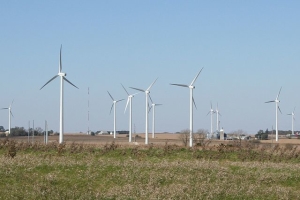In the first post in this series, we reviewed data suggesting that much of the growth in the wind power industry has depended on government regulations such as state renewable portfolio standards (RPS) and financial incentives from tax credits. We also considered some of the benefits that the Obama Administration has cited as reasons to continue to invest in the industry and the infrastructure necessary to support it. In the next post, we looked at some of the ways wind farms can affect the places in which they are built and how some communities have responded. In this post, we’ll discuss a few of the legal cases we have seen involving wind power projects.
Kingfisher Wind Farm
Last fall we wrote about some of the conflict stirred up by Apex Clean Energy’s proposed 149-turbine, 300-megawatt (MW) Kingfisher wind farm in northern Canadian County and southern Kingfisher County, just west of Oklahoma City. As we discussed in that post, the Oklahoma Wind Action Association (OWAA) filed a proposed class action lawsuit for anticipatory nuisance and anticipatory trespass in August 2014 in the U.S. District Court for the Western District of Oklahoma on behalf of landowners who live within 3 miles of the proposed project. The plaintiffs are seeking a permanent injunction to prevent construction of the wind farm. In September, Apex asked the court to dismiss the case, asserting that OWAA has no standing to sue, the class is not currently ascertainable, no physical trespass will occur, and plaintiffs have provided no credible evidence that any plaintiff is likely to sustain a substantial, irreparable harm. On October 7, Judge Tim Leonard recused himself, and the case was reassigned to Judge Timothy DeGiusti. Our previous coverage left off wondering how the new judge would respond to Apex’s motion to dismiss.

Mendota Hills Wind Farm in Illinois, courtesy of Wikimedia Commons user Dual Freq, CC BY 2.5.
On January 26, Judge DeGiusti granted the motion to dismiss in part and denied the motion in part. The anticipatory trespass claim was dismissed, but the anticipatory nuisance claim was allowed to proceed. Class standing as currently alleged was denied. OWAA was denied standing to sue but allowed 21 days to file an amended complaint providing additional facts about the identity of its members and whether they have standing to sue in their own right. On February 25, 2015, the plaintiffs filed an amended complaint, omitting the class action allegations and any claims on behalf of “others similarly situated.” There was a flurry of motions and amended claims filed back and forth throughout March and April, and then on May 13, the parties submitted their Joint Response to Court’s Order to Show Cause, voluntarily dismissing all defendants except Kingfisher Wind, LLC.
The Kingfisher Wind project began construction on May 18. On June 12, Judge DeGiusti found that jurisdiction now exists and the action may proceed. The plaintiffs then filed a motion to expedite the trial and are asking for a permanent injunction requiring a 2-mile setback of turbines from non-participating landowners’ properties. A 2-mile setback is ambitious, but Oklahoma Governor Mary Fallin just signed Senate Bill 808 in April, establishing a setback of 1.5 nautical miles (roughly 1.73 miles) between proposed wind turbines and airports, public schools, and hospitals, so it may not be too much of a stretch to do something similar for nearby landowners.
We’ve noted before that anticipatory nuisance claims can be difficult to prove, but one of the most commonly cited cases where an anticipatory nuisance claim succeeded and a permanent injunction was granted, Sharp v. 251st Street Landfill, Inc., took place in Oklahoma and applied a “reasonable probability of injury” standard (925 P.2d 546 Okla. 1996). Given that Oklahoma state law defines nuisance as an act that “annoys, injures or endangers the comfort, repose, health, or safety of others,” the bar may be a bit lower here than in other cases we’ve considered. We’ll continue to watch this case with interest.
Walnut Ridge Wind Farm
MG2 Tribal Energy has planned the 123-turbine, 210-MW Walnut Ridge Wind Farm in northern Bureau County in northwestern Illinois. MG2 Tribal Energy is a joint venture partnership between Minnesota-based Geronimo Wind Energy LLC and the Mesa Grande Band of Mission Indians, a federally recognized Tribal nation in Southern California. In October 2014, the U.S. General Services Administration (GSA) signed a 10-year power purchase agreement (PPA) to purchase 140 MW of energy from the Walnut Ridge Wind Farm. GSA did not consider possible environmental consequences of the PPA, believing that the contract qualified for a categorical exclusion from federal National Environmental Policy Act (NEPA) environmental review.
On January 16, 2015, more than two dozen property owners near the 14,000-acre wind farm site filed a federal lawsuit, citing likely detrimental effects such as noise, dust, interference with nearby farming operations, and adverse effects to local populations of deer, birds, and bats. The plaintiffs sought a temporary restraining order halting any work on the project, which is not yet under construction, and argued that GSA should be required to conduct a NEPA review of the project’s potential environmental impacts. On May 6, U.S. District Judge Michael Mihm of the Central District Court in Peoria, Illinois, denied the restraining order but ruled that the PPA did not qualify for an exemption from NEPA review. GSA will likely need to conduct either an environmental assessment or an environmental impact statement, which is likely to delay the wind farm project for at least a couple more years. The project has already had to renew its 3-year conditional use permit twice due to previous delays.
Municipal Wind Turbines in Falmouth, Massachusetts
The town of Falmouth, Massachusetts is locked in several legal battles over two controversial wind turbines, including a pair of lawsuits it has brought against its own Zoning Board of Appeals and a pair of consolidated cases filed by residents living near the turbines. Falmouth’s zoning bylaw exempts town buildings from the zoning permit process but doesn’t exempt wind turbines, and town officials never obtained a special use permit before constructing the two turbines. In 2013, the Falmouth bylaw was revised to prohibit turbines with a capacity of more than 250 kilowatts in town. Both of the town’s wind turbines have capacities of 1.65 MW, exceeding the new restrictions. The Zoning Board has ruled that the turbines are a nuisance due to excessive noise and directed the town to remedy the situation. The town has reportedly spent hundreds of thousands of dollars on special counsel for turbine-related legal expenses, and the situation remains unresolved. Earlier this month, the Massachusetts Supreme Judicial Court refused to review Falmouth’s ongoing legal dispute over the two wind turbines installed at the town’s wastewater treatment plant.
Conclusion
These are just a sampling of the many lawsuits that have been filed regarding wind power projects. However, all energy sources have a mix of advantages and disadvantages, and unless we want to give up the energy-intensive benefits of modern society, we need to consider these tradeoffs and plan accordingly as we develop our energy policies. While wind power is a very clean source of energy which uses very little water and has been credited with providing good jobs, the main disadvantages seem to be its current reliance on government support and incentives for financial viability, need for additional supporting infrastructure to store and transmit power, bird and bat mortality, and varying degrees of nuisance reported by some proportion of people residing nearby. Many of these disadvantages can be mitigated with careful project design and operation.






Recent Comments